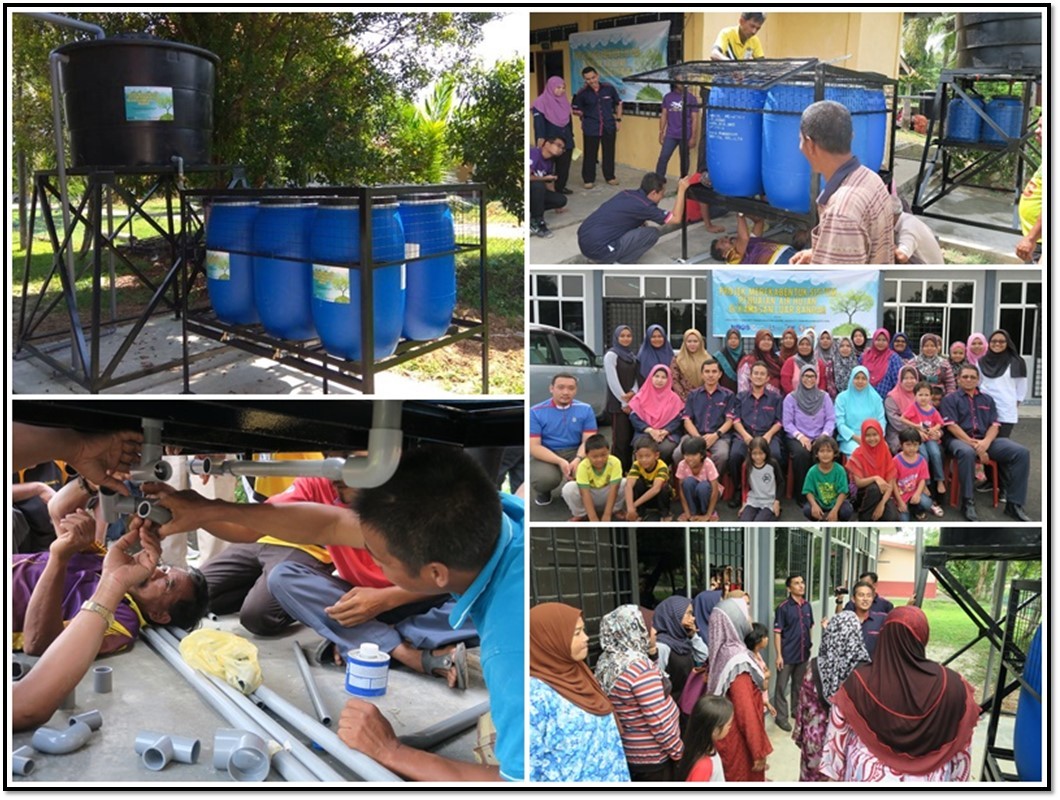
RAINWATER HARVESTER SYSTEM HELPS OVERCOME WATER SHORTAGE AND KEEPS FLOOD AT BAY
UUM ONLINE: The problem of water shortage due to low water pressure in some rural areas is now a thing of the past with the production of rainwater harvesting systems specially designed by a team of Universiti Utara Malaysia (UUM) researchers led by Sr. Dr. Mohd Nazaruddin Yusoff together with Prof. Dr. Rohana Yusof, Dr. Azlizan Talib, Za'im Ahmad and Dr. Hazeline Ayoup.
According to Sr. Dr. Mohd Nazaruddin, his team selected the Bukit Lada Mini RTC and the KEDA Bendang Perang Village, Jabi as the location of the Project for Designing Rainwater Harvesting System in Rural Areas in view of the low water pressure problem faced by residents of the two locations.
He said water, a vital necessity for human as well as the natural ecosystems, hence the concept of rainwater harvesting came to being in accommodating the existing water supply where the supply would at times become disconnected due to leakage of pipe, water rationing and pipeline repairs.
"This system is considered as the best management method practiced in Malaysia that not only reduces flood risk, but also becomes a free alternative source of water and is safe for use.
"Hence, rainwater harvesting is seen as an alternative source based on safe and sustainable green technology," he said at a special ceremony when handing over the Rainwater Harvesting System at KEDA Bendang Perang Village, recently.
He said the system had two main functions, namely On Site Detention and Rainwater Harvest, while the catchment area was built in accordance to the surface area of the roof of the building.
According to him, On Site Detention Storage served to decelerate the runoff of rainwater on the surface by holding the rainwater for a while, while the rainwater harvesting tank served as a rainwater supply for general use.
He said the system was built on roofs with wide surface area, the troughs were placed at suitable areas to harvest the most amount of rainwater when it rained and construction of tanks made of concrete was done to ensure stability, strength and safety apart from the installation of outflow pipes at the suitable positions.
However, he added, the rainwater would only be suitable for daily use and not for consumption because untreated rainwater would be mixed with roofing dirt containing chemicals, thereby affecting health.
"Most of the harvested rainwater is only reserved for daily domestic activities such as bathing, washing of toilets, watering of plants and washing of vehicles," he said.
Fellow team member cum Director of the Northern Corridor Research Centre (NCRC), Prof. Dr. Rohana said the University Community Transformation Centre - Universiti Utara Malaysia (UCTC-UUM) had successfully helped the community by carrying out the Designing Rainwater Harvesting System Project.
According to her, the project received finance from the NBOS - UCTC grant, Ministry of Higher Education with the cooperation of the District of Pendang, Kedah Regional Development Authority (KEDA).
"The project is designed with the goal of providing benefits such as promoting the use of natural water resources, saving the use of clean water and delaying surface runoff, as well as instilling awareness of the value of water resources.
"In the long run, Bukit Lada Mini RTC will be an example to the entire community regarding the process of effective rainwater harvesting, while the RTC management team acts as an advisory service centre to the community regarding this system," she said.
Meanwhile, resident of KEDA Bendang Perang, Mr. Ridzuan Hassan, 34, welcomed the project which had brought about positive impact on the local residents who have long faced water supply problems.
According to him, the knowledge in designing the project could help residents solve water shortage problems in their homes at low cost and easy systems, as well as saving on long-term spending and consumption of pipe-water.
He added that the knowledge gained through theoretical and practical training was very useful and able to increase the income of youths involved in small-scale industry activities in the production of rainwater harvesting systems.
